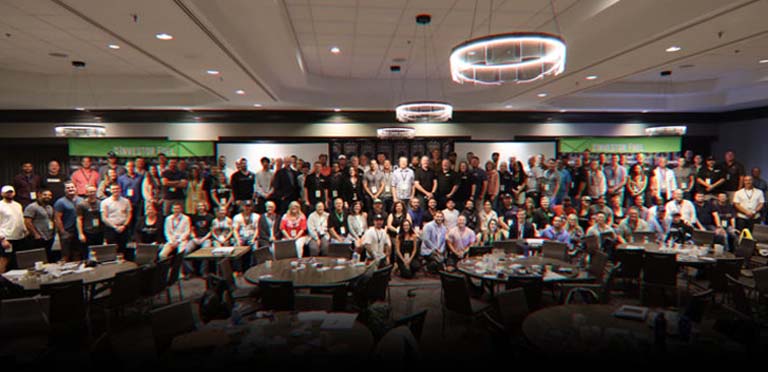
Show Summary
In this conversation, John Harcar interviews Simon Beylin, a seasoned real estate developer, about his journey from dentistry to ground up construction. Simon shares insights on the challenges and opportunities in the construction industry, particularly in multifamily and residential development. He emphasizes the importance of mentorship, understanding the entitlement process, and the need for careful financial planning in real estate projects. The discussion also touches on current market trends and the keys to success in the real estate business.
Resources and Links from this show:
Listen to the Audio Version of this Episode
Investor Fuel Show Transcript:
John Harcar (00:01.641)
All right. Hey guys, welcome back to our show. I’m your host, John Harcar. And I’m here today with Simon Beylin. And what we’re going to talk about besides his journey in real estate and business, we’re going to talk about ground up construction. And if done the right way, how it can be very fruitful. Remember guys, at Investor Fuel, we help real estate investors, service providers, I mean, all real estate entrepreneurs, two to five X their business. We do it by
the tools and resources and opportunities to grow the business you want to grow and in turn live the life that you wanted to live. So Simon, welcome to our show.
Simon Beylin (00:37.09)
Thank you so much for having me, John.
John Harcar (00:38.751)
Man, I appreciate you coming on here. look forward to talking about ground up. I’ve had a couple actually podcast guests that had talked about the ground up. But before we get into all that, why don’t you tell our audience a little bit of kind of about you, your experience in business and real estate and what got you to today.
Simon Beylin (00:55.598)
So I grew up around construction. father had a pretty decent size electrical company. They get a lot of ground up subdivisions, hotels, apartment buildings. Then I went off to dental school, became a dentist and then an endodontist, a root canal specialist. And I was practicing and intending to be a practitioner. My wife’s also in the dental field. So we started building our dental offices and you’re from California, I’m from California.
Construction on the East Coast is very different from what it is on the West Coast. Just timelines aren’t adhered to. Construction quality is a little bit on a different level. If somebody told you your process is going to take 24 months in California, think they pretty much, it was 24 months or less. Everybody was scared of being sued on the East Coast. It’s very different. If they tell you 24 months, you’re lucky to get in 30. So it’s had an awful experience.
John Harcar (01:26.975)
How so?
Simon Beylin (01:52.047)
I got my contractors license and we started just building our own practices, our own offices for our dental offices. And we started building offices for our colleagues as architects, refer them. And then we went full on into ground up. I had a little bit of injury so I couldn’t practice dentistry anymore. I just shifted and went full bore into ground up real estate.
John Harcar (02:15.709)
Awesome, okay, so let’s kind of go backwards a little bit. You took my favorite question to ask people right off the block. I normally ask, was there any influence growing up, anybody in real estate or real estate related business that kind of spurred the seed, right? And you mentioned that, your father. The other question is, you around that, saw that, why didn’t you go into that? Why did you choose dentistry?
Simon Beylin (02:21.1)
Ha ha.
Simon Beylin (02:30.764)
Yeah.
Simon Beylin (02:40.914)
So even my father, even though he owned a company and they were electrical contractors, he went to school as an electrical engineer. So he always thought it was very important that first, you know, get getting an education first. And then if you want to do this construction stuff and get the gray hairs, you’re welcome to do it. Get the get the knowledge first. I think that is that is important. I think almost anybody if they put their mind to it can can do what we do in construction and ground up development. But it definitely helps for us when you’re ground up and go to the bank and
John Harcar (02:55.467)
Mm!
Simon Beylin (03:10.53)
say, hey, I’m also an endodontist and I own these dental practices and I have this cash flow over here. You’re not only relying on your real estate business, they see the bank seat as an investment. Even though it’s what we do day in and day out, it’s still an investment and you’re playing in the dirt and you’re building these buildings and hopefully it works. But if you still have some cash flow, because we still own our practices and they cash flow very well, it’s much easier for us as professionals to get loans to do construction and development.
John Harcar (03:15.723)
Mm-hmm.
John Harcar (03:39.115)
Okay, so when you started your dental practices, you were just renting buildings or were you buying the buildings and then rehabbing them before you started kind of just building your own?
Simon Beylin (03:47.599)
Yeah, so I mean, you get out of school and typically you’ll become an associate for somebody else. You’ll work under their practice. But as soon as we went to open our first offices, I was very against renting a space. then in terms of construction, dentistry has the highest cost per square foot out of any type of construction. So if I’m to put all that electrical and plumbing into a slab and then have a landlord telling me I need to move in five years, me, that didn’t work.
We always purchased our spaces and then we built them out from there. I try to tell all my colleagues to do the same. Some listen, some are fine with renting a space and they’re comfortable with that. I wouldn’t sleep at night if I knew I put a million dollars into a build out and then had to leave in five or 10 years.
John Harcar (04:33.183)
Right. Okay, very cool. So you’re building, you’re starting to build these offices. What were some of like the beginning struggles? What were some of the things that, you know, were kind of difficult as you got started?
Simon Beylin (04:45.55)
The beginning, especially around here, a lot of the subs, it seems almost like a little bit of a boys club. So they want to work with the GC that they’ve worked with for five years. So to get that good sub to come and work for you is a challenge. But when they see that you take care of them well, you’re not beating them off their price, you’re paying them when they’re supposed to be paid. You establish that relationship and then they want to follow you. So we start off by
John Harcar (04:52.555)
Pfft.
Simon Beylin (05:11.97)
building in like a 15 mile radius of our offices. And now I have the same subs that we’ve been using that will travel all throughout New England from, we’ve built in every state in New England except for Vermont. same subs travel with us state to state.
John Harcar (05:24.03)
Okay.
John Harcar (05:27.603)
Awesome. Well, I if you have a good team, you want to take them with you wherever you go, obviously, right? Okay, very cool. So as you’re growing, you know, this business and you’re building it all out, I mean, what are kind of some of the key things you’re looking for when you’re looking to build? Like, is there certain areas, I mean, you’re trying to stay in industrial areas? Where are you building these offices?
Simon Beylin (05:31.499)
Absolutely.
Simon Beylin (05:48.623)
So most of what we’re doing now is actually on the residential side. just for my own portfolio, built to hold residential. So if there’s space, we’re building a 19 unit right now that has commercial on the first level and likely a dentist will go in there because we’ve been approached by several dentists. So I’ll still build out those offices, but we’re almost shifting completely towards ground up at this point residential. I look for.
John Harcar (05:52.915)
okay.
John Harcar (06:14.131)
Okay. And where did you learn all this construction and contracting stuff? I mean, I know your father, you mentioned, I think he’s an electrical contractor, right?
Simon Beylin (06:22.232)
Correct, so he was an electrical subcontractor, learning it, mean, what we learned in dentistry, reading x-rays is actually very similar to reading blueprints. So they actually use blueprints as part of the exam to get into dental school. That’s how you test your perceptual ability. They give you 2D blueprint, you need to know what it looks like in 3D. So it’s very similar to reading x-rays. And then just, I hate to say it, but like anything else in the world, if you want to learn it, just go to YouTube.
John Harcar (06:25.418)
Okay.
Simon Beylin (06:50.19)
There’s videos on anything you want to learn. And then just jump in head first. On my first office that I ever built on my own, I worked with the same architect that did our first office for us, previous, that we did not build. And he told me I was crazy. And he would treat me like any other GC. He wouldn’t be easy on me, he’d be difficult. So I just remember taking that set of plans and rolling it out and just beating into my head until…
I understood and maybe feel silly on a couple of my questions and you don’t want to feel silly so you just go out there and learn on your own.
John Harcar (07:27.369)
So would you say he was kind of like a mentor for you?
Simon Beylin (07:30.846)
So yes, so he was a mentor on my first projects, but in terms of mentorship, I did have another mentor for ground up because I can build anything from a set of blueprints, but going through entitlement process and going through the entire process of getting a project approved from Dirt to actually building units and leasing them out, I had no idea how to do that. So I did team up with a mentor for that. That was Greg Dickerson.
John Harcar (07:56.203)
Okay. Awesome. Why was it important for you to seek out a mentor versus, you know, like you said, YouTube you?
Simon Beylin (08:02.862)
I think you’re just lessening that learning curve. you get somebody who’s done something that you want to do, they’re 20, 30 years ahead in their career, and you can just learn from their mistakes. So if you have the ability to work with a mentor or work with a group or a mastermind, Greg also had a mastermind, you’re just working with people who are just further ahead in the journey than you are, and you’re gonna lessen your learning curve quite a bit.
John Harcar (08:28.041)
Right, okay, awesome. So as your business is growing, like where do you guys plan to take it? I mean, I know you’re going into the residential side. Are you gonna be building singles? Are you gonna be in the multifamily space? What does that all look like, your trajectory?
Simon Beylin (08:43.278)
So most of what we’re doing today is multifamily. We do have four single families in the ground, but the only reason I took those on is to show my group of followers who are dentists or physicians that you can build a single family house on the side of your practice and show up once a week or twice a week off hours when you’re not seeing patients and roll a couple of those into a multifamily. And then one 30, 40-year multifamily can out-earn what you do as a clinician.
So if you want to send the kids through college, know, five, 10 years, take a cash out refi, and you still have the asset and keep it for life. So we try to teach physicians and dentists to do that. Luckily, I had something there on the side for me when I was injured. A lot of people don’t, so you gotta go look at what’s gonna carry you through if you’re injured or you wanna retire.
John Harcar (09:37.387)
Now, I don’t know if I might have mistaken. Are you coaching people as well? Do you have a coaching business for Ground Up or anything like that?
Simon Beylin (09:45.555)
We do a mastermind four times a year. We hold it in Maine. About 40 people show up and almost all of them are physicians or dentists and we just kind of show them around. I’m not doing anything like one-on-one or like a weekly mastermind but just to show open their eyes, walk them through some of the different job sites and show them that it’s possible.
John Harcar (09:48.905)
Okay.
John Harcar (10:06.207)
Got it. Okay. And before we start talking a little bit more about the ground up and how it can be fruitful if done the right way. What does your team look like right now? Where are you guys focusing? Like what is, what projects you got going on?
Simon Beylin (10:18.126)
So we just finished a 33 unit. We’ve got a 19 unit with ground level commercial as well a 34 unit a 48 unit 45 unit Another 48 unit all in the New England area So everything right now is 50 units or less and those seem to pencil very very well right now Just the time that we start to the time that we get rent out There’s very little carrying costs and the high interest rate environments not
backing us. We had a couple other larger projects that we had under contract and just by the time that it got to the point where we get shovels in the ground, just didn’t pencil anymore with rates jumping almost a full percentage point. So we passed on those. But anything in that 30 to 50 unit, I know they call it the forgotten middle. It’s small for your mom and pops, too large for your mom and pops, but too small for the institutional guys. Those are penciling very well right now. The 33 we just finished was a
John Harcar (11:06.347)
Mm.
Simon Beylin (11:16.91)
a 12 unit, a 12 unit and a nine unit all in the same property. And we can roll through lease up while we’re moving through the property and have very little downtime. So that three years or two years that we’re getting interest on from the bank, we’re up reserves. Once you get to 90%, if you wanna cash out refi, can, or just keep it with the lower rates that we had.
John Harcar (11:37.161)
Why do think those are kind of like you said, like the forgotten ones, know, the two, two big from a pop tube, too small for institution. Why are you, why are those like kind of like forgotten and why are these penciling so well now?
Simon Beylin (11:47.887)
Um, so I think the institutional, uh, funds, they, want a hundred doors or more because, um, they’re, more manageable in terms of being able to have one manager on site full time or for a 30 unit doesn’t make sense to have a manager on site full time. But if you have two or three 30 units within a couple of miles of one another, you can have that manager that’s between all three sites. So you have to just look at it differently. Um, we’ve, we’ve been fortunate. We actually have a new team member that joined and he came from a company.
that four years ago had 17 employees and they ballooned to 70 employees in four years. And they got under the little impression that you always should touch if projects that are 200 units and above, but they’re not penciling now. So they have a large void for their project flow in the next three years and they’re back down to 15 employees. So that cycle is not one that I wanna be part of. if one of my…
project managers brings me a project or anybody brings me a project and it’s 30 units I’m not gonna laugh and say oh it’s so small we don’t want to touch it if it pencils the pencils take it on and when rates are back down the fives we can go back and look at the hundred units and above but if they pencil out a 30 unit why not why not keep the guys busy and keep the property and if you want five ten years you could roll up three properties in a portfolio and sell them off or you keep them
John Harcar (13:11.007)
Right? Okay. So let’s talk about ground up and how we mentioned, you know, it could be fruitful if it’s done the right way. How are people doing it the wrong way?
Simon Beylin (13:22.382)
I think we all get in over our skis when you think, you know what, if part of the formula doesn’t work, we’ll just catch up at the next part of the formula. So I always say, you’re looking at the land, the land price per unit doesn’t make sense. You don’t go to the next step. But the guys that do it the wrong way say, you know what, we can overpay on land because we’ll save on the civil and we’ll save on the architectural drawings. No, you won’t. Because whatever your budget is there, it’s going to be more than what you expected as well. So just come to compounds all the way down.
So I don’t move from one point to the next unless it makes sense. It needs to pencil each and every single step of the way and multiple points of exit. So we’ve had some projects that take a year or two to get through underwriting, get through your entitlement process and you look at it as, can you sell a project as entitled dirt? Can you sell it as rental units? Can you sell it as sold units if you condo it out? Or can you keep it as a long-term asset and rent it?
So just multiple points of exit if something turns the wrong way. I also never will close on land unless it’s entitled. So I’ve walked away from, it’s probably 12 deals to one where you just have a seller who will work with you on the entitlement process. But I’m not gonna close on a piece of land if I can’t build it. So those that understand, sell their land. Those that don’t, keep their land for decades until unfortunately they pass and then their kids sell it at a discount.
John Harcar (14:39.563)
Mm-hmm.
Simon Beylin (14:51.63)
That’s what we see in this area.
John Harcar (14:53.963)
For some of our folks that maybe are on here that are listening that maybe aren’t as knowledgeable about, what is the entitlement process? What is entitlement?
Simon Beylin (15:03.854)
So you buy you buy a piece of land and for me as something that’s looking for residential I want to know how many units I could put on this piece of dirt and getting the entitlements or all the approvals so you’re going through your Planning board zoning if you need any zoning changes Depending on where you are in town. You may have a design review board. You may have historic boards environmental so it’s all the different permits to have your subdivision approved if it’s a subdivision
or even if it’s an apartment building that’s not gonna be subdivided, but to get to that goal. So if I wanna put 100 units on this piece of land, it’s all the steps necessary to get that 100 units approved, minus your actual architectural and structural drawings, because those, I won’t even start architectural, structural or mechanicals, electrical and plumbing until I have the dirt or the site approved. So you’re working with your civil engineer.
And you really, I call it turning dirt into dollars, because you take a piece of dirt that’s not, it’s worthless, I it’s really worthless. And once it’s entitled in this area, it’ll go from 40 to $100,000 a door, depending on what you’re entitling. But before it’s entitled, it’s worth nothing. So that’s one of your points of exits. And a lot of developers do just that. They just do land development. I’ve tied up millions of dollars of land for $10,000.
So you say, I’ll give you $10,000, I want 180 days with two 180 day extensions. And that 180 days you’re working with your civil engineer and you’re getting all of your approvals. And then once it’s approved, you could take that same piece of land that you had under contract for less than, or like around the million bucks, you turn it and flip it for five, six, seven, eight million dollars. Once it’s entitled, it’s worth a lot to builders. A lot of builders do not want to go through that development or entitlement process.
John Harcar (16:54.987)
What are some of the cons of ground up construction? I think you just said one of them right there and some builders don’t want to go through that entitlement process. But what are some of the cons of ground up versus, you know, traditional single family flip?
Simon Beylin (17:02.146)
Yeah.
Simon Beylin (17:09.742)
So I mean compared to even a flip you kind of have comps, know, you know what that hopefully, you know that comps gonna sell for you know, what your value is when you buy it what your after repair value should be With development. It’s a little bit different. So you may be making the comps There may not be a product like what you’re building in that town. So you’re kind of You’re going to a little bit of an unknown But you got to just reduce those unknowns and as long as you can reduce the unknowns It makes a lot of sense
but a lot of people compare ground up development of let’s say 100 unit building to an existing 100 unit building. So the large differences there, when you’re getting a loan on that 100 unit existing building, they’re not looking at your financials. They’re looking at can that building sustain itself with you or without you, it doesn’t matter because if you fail, they’re just gonna put another operator in there. Development, they look at you as a developer. So they look at your financials, your signing your house and your businesses on each and every single loan.
They want to know your ability to bring this project to fruition because there is no project to sell until it’s completed And halfway through bringing somebody in is very expensive and not something the bank wants to do
John Harcar (18:17.803)
Yeah.
John Harcar (18:23.249)
I get that. What trends are you seeing in the ground-up construction world?
Simon Beylin (18:27.822)
So a lot of people are slowing down. Massachusetts stopped over a year ago. We’re based out of New Hampshire, but a lot of what I’m doing is in Maine right now. You know the tides are turning when your civil engineers are calling you, because they’re the first ones to see the slowdown, right? So it comes from New York and then works its way up. So the roofers will know last. But a couple of years ago, you couldn’t get a civil engineer on the phone.
John Harcar (18:45.535)
Yeah, yeah.
Simon Beylin (18:54.232)
Today, they’re calling you and asking you to take on other projects. So we are seeing a slowdown, but if you’re positioned well, you’ll take care of yourself and you’ll do very well on the slowdown. Cause a lot of subs are now going back to pre-COVID pricing on their work. Supplies coming down to pre-COVID pricing. So those that survive are gonna do very well.
John Harcar (19:18.569)
What do you credit your keys to success? mean, obviously you’ve had some great growth. mean, something like a great business. What do you credit your success to?
Simon Beylin (19:27.95)
Just grit. Just I know what I want. I have a clear path on how to get there. You just got to get up there, put on your boots every day and just make it happen. Nothing’s going be handed to you. You got to learn and I think in this business, you do not have to have exceptional training. You could learn a lot of this in the real world. And if you want to apply what you learn in the real world and you have the proper mentorship, you surround yourself with people who are doing
what you wanna do, you’ll do very, very well. Coming from the medical and dental side, it was cutthroat. Like everybody wore in that top scene class. It’s cutthroat when you get into practice. That’s just the way it is. Where I think in real estate, like almost anybody in any group, you go to a mass run, they’ll give you the shirt off their back. Everybody’s open, everybody wants to share. There’s plenty out there. Nobody’s competing against one another. And for the most part, I’ve met people.
John Harcar (20:13.983)
Yeah.
Simon Beylin (20:24.11)
in our mastermind who asked, can you hold my hand through ground up development? And I say, not only will I hold your hand, I’ll put half of the funds up for it and we’ll do drop. Where else are you gonna get it? In most other fields, you won’t get that. Here, we all grow better as a team. So those who are smart and real estate understand that and they’ll literally give you the shit off.
John Harcar (20:33.411)
yeah. Yeah.
No, no, no, no.
John Harcar (20:47.355)
And that’s kind of the mantra of our mastermind as well. It’s like, know, before you get, you gotta give, you know? So when people talk about their businesses, they come up with a give first. That’s so awesome. So if there’s folks out there that are listening to this that might be in your area, or maybe they just kind of want to invest in some of your projects, how can they find out about what you got going on and how can they get in touch with you?
Simon Beylin (21:09.582)
My website is www.baealindevelopment.com. It’s B-E-Y-L-I-N. And you can follow us on social media as well. So we have all our social media links on there. And my personal cell phone is on the website. if you want to send a text, great. Don’t call me in the middle of the night. The phone’s off at 9 o’clock. But as long it’s not the middle of the night, I’ll answer almost anybody’s question. Help them along their path.
John Harcar (21:34.123)
That’s awesome. That’s so giving, man. I appreciate you, Simon, coming on here and talking about all this and giving your time. Guys, I hope you enjoyed it. We’ll put all that information to contact Simon in the show notes. But I look forward to seeing you guys again on the next one. Simon, thank you again for your time. And everybody have a good night. Cheers.
Simon Beylin (21:53.113)
Thank you so much. All right. Cheers.






